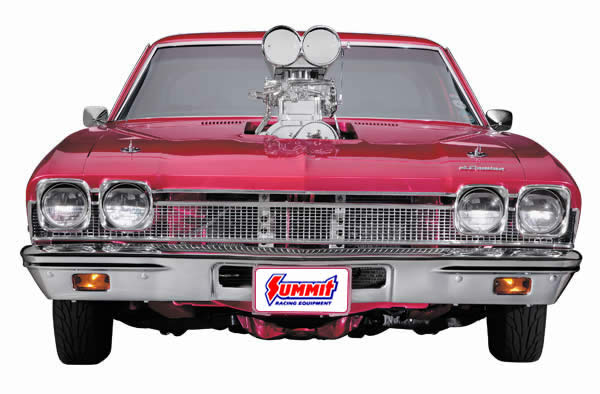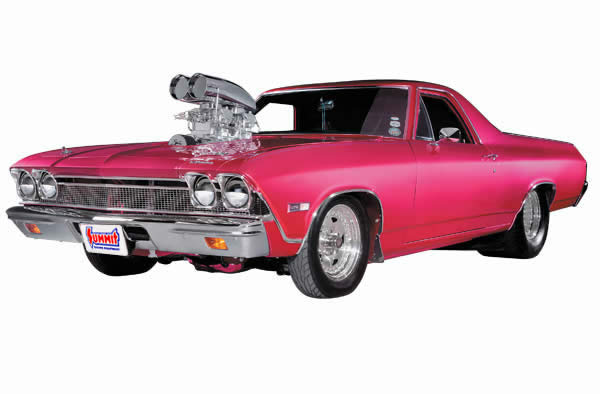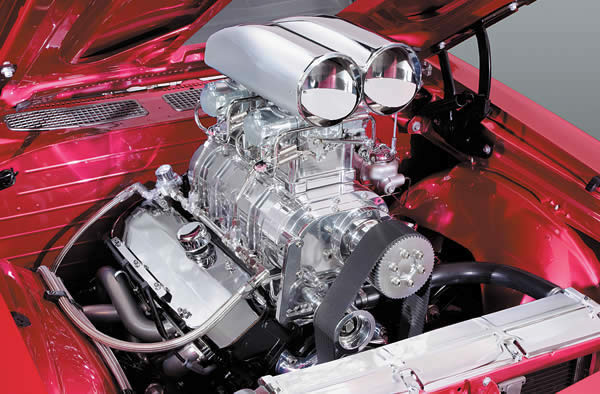Wanna make jokes about the color of Al Stacko’s award-winning ride? You’d best bring your A-game material, friend, because he has heard them all and emerged unflustered.
“Some guys from the Rock-n-Roll Capital Street Machines car club and I were at Autorama one year, and I had stepped away from my truck for just a minute,” Al said. “Out of nowhere, the guys produced all these Mary Kay cosmetic products and set up a big display on the El Camino. I came back and thought it was pretty funny…until I saw the judges heading my way!”
Perhaps Violet Red Metallic is not an obvious first choice for the paint scheme on a burly Pro Streeter with the supercharged heart of a lion, owned by a life-long, “American Graffiti” style hot rodder. As it turns out, Al didn’t choose the color—the color chose him.
“It was this color when I first saw it at a swap meet back in 1997,” Al said. “Normally, I’m a Chevelle guy who wouldn’t give a second look to an El Camino, but that color caught my eye. When I got closer, I realized the body was in nearly perfect condition, which would shave months—maybe even years—off of any project for that car. Something about the way all the lines and slopes on the El Camino matched up struck a chord with me, too. Plus, the guy was selling it for a guy who was getting a divorce, so the price was good.”
Thus inspired, Al took the El home, where it became one of those permanent projects. Over time, doing virtually all the work himself, he stripped out the old, sub-par internals for performance upgrades, and the vehicle took on its Pro Street character.
In 2008, Al finally found a way to one-up the paint: the towering Chevy 468, topped with an 8:71 billet aluminum supercharger from The Blower Shop, and a double-barreled chrome scoop. Like a piece of fine art, the engine is surrounded by lots of open space for maximum admiration, thanks to Al’s trick install.
“First of all, I wanted no wires showing,” Al said. “That’s why they’re tucked underneath, and the distributor is hidden in back. By using solid motor mounts, I was able to bring the headers in tight, and frame-mount the Summit alternator. I also custom-made these hard fuel lines to follow the contours of the blower case.”
Al really beams about the hood opening, which he carefully crafted with a raised lip to follow the stock lines of the hood. It looks like it rolled out of the factory with a big hole in it just for a gigantic supercharger! When asked about the custom alternator bracket, Al swears us to secrecy.
Don’t hate it because it’s beautiful; hate it because it’s barely-street legal performance (clocking in at 850 hp) will knock your socks off.
“When you have a vehicle like this,” Al said, “it pays to be a really good neighbor. They don’t mind the rumble now and then.”
While Al has done most of the work on the car himself, he is quick to credit the Rock-n-Roll Capital Street Machines car club for the support, advice, and motivation.
“I first met them in 1999,” Al said. “I just kept seeing them at local cruises and car shows, and so I started talking to them, and the next thing I know I’m a member. They knew all the best local shops for specific jobs. Plus, we got to compete against clubs from other areas, where they had new and different ideas to inspire us.”
But Al’s favorite club functions always involve driving the El Camino, especially for parades and cruises. With its shocking paint, dazzling engine, and distinctive styling, the truck always invites folks along the parade route to crowd in for closer looks. “When they get too close, and the cruise gets slowed down, I just blip the throttle a bit, and the blast from side pipes makes them back up fast!”
As much as the El Camino evolved over the years, Al was changing right along with it. “I really found that I liked to get out, meet people, organize things, and solve problems,” Al says. “To help the club, I taught myself how to write better letters for sponsorship and donation requests, how to design signs and posters, and how to be an ambassador for the club and the hobby.” Eventually Al stepped up to become vice-president of the club, and in late 2010, became president.
In fact, Al is such a changed man that his club business cards and his show display identify him as “Al Camino.” Chevelles still hold a special place in his heart, and his latest project vehicle is a gnarly Mercury rat rod, but it is for the El Camino’s magenta majesty that he is best known. “It’s an unforgettable sight,” says Al.
Al knows the El Camino will never really be done. Every now and then he’ll get an idea, and just try it out. “I had some folks offer to airbag it,” he says, “but it didn’t fit the spirit of the project.” Someday, he might smooth out the rivets in the engine compartment and the bed, or make a few other changes, but one thing will never change.
“People have called me crazy, tried to talk me out of it, but the color is permanent. The kids love it, and so do the ladies!”
FAST SPECS
Chassis
Frame: Pro Street chassis with narrowed back half, Competition Engineering roll cage
Suspension: Competition Engineering shocks with Hotchkis springs (front), Koni Gas-a-Just shocks (rear), Competition Engineering Ladder Link bars, Summit drop spindles
Brakes: Stock GM front disc brakes, Ford 11-inch rear brakes
Wheels and Tires: Center Line Convo Pro wheels (15-inch x 4-inch front, 15-inch x 15-inch rear), with Mickey Thompson Sportsman S/R Radials (26 x 6.0R15LT front, 31 x 18.0R15LT rear)
Engine and Transmission
Engine: Chevrolet 468 cu. in., overbored .060-inch, line honed
Engine Machine Work By: Michaels Racing Engines
Reciprocating Assembly: Stock GM cast steel crankshaft, Eagle ESP H-Beam connecting rods, Wiseco Pro Tru forged 9:1 CR pistons, Clevite bearings; balanced
Cylinder Heads: Stock GM cast iron square port heads, ported and polished, closed combustion chambers, Manley stainless steel valves (2.25-inch intake/1.88-inch exhaust)
Valvetrain: COMP Cams Xtreme Energy hydraulic roller camshaft (.248-inch/.254-inch @ .050-inch, .561-inch intake/.581-inch exhaust lift), COMP Cams Endure X hydraulic roller lifters, Crane chromoly pushrods, Crane Gold Race aluminum roller rocker arms, K-Motion valve springs, COMP Cams steel retainers, Moroso fabricated aluminum chromed valve covers with Moroso breathers
Induction: 8:71 billet aluminum supercharger and intake by The Blower Shop, two 750 cfm supercharger carburetors, chromed double-barrel scoop
Ignition and Electrical: MSD Pro Billet electronic distributor, MSD 6-BTM ignition box, MSD Blaster coil, TCI Permanent Magnet Racing mini starter, and Summit 140 amp chrome alternator with custom-built frame-mount bracket
Exhaust: Jet-Hot coated Hooker Super Competition 2 1/8-inch headers, three-inch exhaust pipes, Dynomax Race Bullet mufflers
Other Items: Be Cool Aluminator aluminum radiator, March Performance/The Blower Shop underdrive pulleys, custom 5/8-inch stainless steel fuel line feeding independent hard lines that follow the supercharger case, Edelbrock Victor water pump, Aeromotive A1000 fuel pump with diaphragm bypass return, Melling high-volume oil pump,Moroso solid steel motor mounts
Transmission: GM TH-400 manual with TCI reverse-pattern valve body, B&M Holeshot torque converter (3,500 rpm stall)
Shifter: Dedenbear Turbo Action Cheetah SCS with trans-brake
Transmission Built By: Al Zaitz
Exterior
Body: 1968 Chevrolet El Camino
Custom Features: Stock with smoothed/filled tailgate, hood cut-out and reworked following factory profile of centerline around supercharger opening, removed/smoothed fuel door, wheel tubs, re-worked bed area
Paint: Sikkens Violet Red Metallic
Body Work and Paint By: Al Stacko
Interior
Front Seats: Summit race seats with black leather covers and RCI 5-point camlock harnesses
Upholstery By: Al Stacko
Dash: Modified Pro Stock-style
Gauges: Auto Meter Pro Comp series
Performance
Approximate horsepower: 850 hp at 6,500 rpm
Approximate torque: 715 ft.-lbs. at 5,800 rpm
Awards
ISCA Outstanding Street Machine Award: 2007, 2009, and 2010
Cleveland AutoRama First Place: 2007, 2009, and 2010
Super Summit XVI Top 50 Award: 2008
ISCA Best Engine Compartment Award: 2009
ISCA Best Interior Award: 2009
Special Thanks
My wife Cindy, Wally Hunter, Al Zaitz, Red Brosnan at H & H, Michael Pietro at Michaels Racing Engines, Anton “the Madd Bomber” Lanesky, and Richard Johns
Photography By: Maguire Photographics













[…] Buick GS, and a 1984 Cutlass. He got to know other local customizers, including Al Stacko (a.k.a. Al Camino) and Joe Mazzola (builder of this 1970 Plymouth Hemi […]
[…] Elco has made appearances in countless movies, has been featured in many magazines and blogs, including OnAllCylinders, and has been driven by some pretty famous folk—check out this list of famous El Camino […]
[…] Elco has a look all its own. It has been featured in auto magazines and blogs, including OnAllCylinders, and depending on the model year AND build style, has either been the butt of jokes or the objects […]